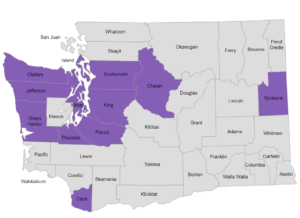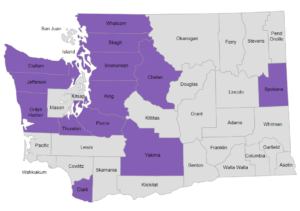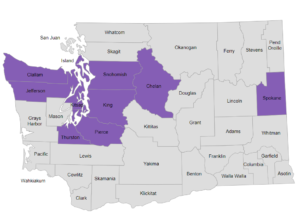Written in 2011 and updated in 2014 by Jana Heyd1
Chapter Sections
Introduction
A new permanency option for children who are not in permanent placements was created in July, 2007 when the Washington legislature passed ESHB 1624, the Parental Reinstatement Bill, now codified at RCW 13.34.215. Approximately 10 other states now have similar legislation.
Prior to the passage of the parental reinstatement legislation, it was not uncommon for an adolescent to request a return to the parental home even if parental rights had been terminated. Until 2007 there was not an appropriate statutory basis to allow placement. The child could request that his or her attorney (if the child had an attorney) set a motion hearing in the dependency case to request placement with a (terminated) parent. The court might have considered placement with the terminated parent if the placement was determined to be with a “suitable person” or a “relative.” In family court, a terminated parent could petition for a “non-parental” custody action , but the dependency court has exclusive jurisdiction over the child, which made it difficult for the parent to bring a custody action in family court unless there was concurrent jurisdiction between both courts. Neither of these options made the parent’s rights very clear and neither gave the parent the legal ability to be heard in juvenile court where dependency cases are heard. The new statute has provided terminated parents with the option of resuming their status as the legal parent.
§1 Eligibility
As of 2007, RCW 13.34.215 allows a youth who is over the age of 12 to petition the court to reinstate the parent’s previously terminated rights if the child is not in a permanent placement and at least three years have passed since the termination of rights. 2
Legislation in 2008 allowed the court on its own motion to petition for reinstatement as well as for a child under the age of twelve (12) to petition if it is in the child’s best interest.
In 2011, the law was amended to clarify that if a child had been in a permanent home, but the placement had not been sustained, the child was eligible to petition for reinstatement if the other requirements were met. 3
§2 Notification to Child
If a parent of an eligible child contacts the Department of Social and Health Services (DSHS) regarding reinstatement of parental rights, the supervising agency, the child’s guardian ad litem (GAL) or court-appointed special advocate (CASA) , is required to notify the child of the right to petition for reinstatement.4
§3 Representation of Child
Prior to the enactment of RCW 13.34.100 (6)(a) Washington’s laws regarding appointment of counsel for children made the child’s ability to advocate for return to a terminated parent difficult in most counties in Washington because children were not routinely appointed counsel in dependency cases. With the change in the appointment of counsel law for legally free children, children of any age are now appointed counsel once the parents’ rights have been terminated for six months and the child is not in a permanent home, and therefore will have access to counsel long before becoming eligible to petition.
RCW 13.34.215, , additionally provides for appointment of counsel for any child who petitions the court for reinstatement of parental rights.5 This was Washington’s first uniform law and practice for appointment of an attorney for a child in a dependency proceeding. The statute also allows appointment of a GAL in the reinstatement proceeding.
§4 Threshold Hearings
Once the child files a petition to reinstate parental rights, a threshold hearing is set 6to consider the parent’s fitness and interest in reinstatement of parental rights. At that hearing, the child must show by a preponderance of the evidence that the best interests of the child may be served by reinstatement of parental rights.7
§5 Hearing on the Merits of the Petition
After the threshold hearing and if the Court has determined that the child has met his/her burden of proof on the threshold requirements, a hearing on the merits of the petition is scheduled. .8 At that hearing, the petitioning child must show by clear and convincing evidence that he or she (the child) has not achieved a permanent plan which has been sustained, and is not likely to achieve such a plan, and that reinstatement is in his or her best interest.9 For children who have experienced many placements and continue to reside in temporary homes, it is fairly easy to establish the lack of a permanent plan and that the rehabilitated parent may be the only option for the child to have a permanent home. Likewise, if the birth parent is the only permanent option, the parent has stabilized and the relationship is a positive one, establishing “best interest” may be fairly straight forward.
§6 Notification to Interested Parties
Prior to any hearing, the DSHS or other supervising agency must give notice to all interested parties including the parent whose parental rights are at issue, any parent whose rights have not been terminated, the child’s current foster parent, relative caregiver, guardian/custodian, and the child’s tribe (if applicable).10
§7 Burden of Proof
At the threshold hearing, the court must order a hearing on the merits of the petition if it finds by a preponderance of the evidence that reinstatement is in the best interests of the child.11
At the merits hearing, the court must conditionally grant the child’s petition if it finds by clear and convincing evidence that the child has not achieved his or her permanency plan and that reinstatement is in the best interest of the child.12
§8 Considerations of the Court
Generally, the children who petition for reinstatement of parental rights have maintained a relationship or contact with the parent. In some cases, the child has been living with the parent, either unofficially, or with court permission on a “visit” or other type of temporary placement. The child’s counsel is required to show that the parent(s) has dealt with the issues that caused the court to terminate rights—that the parent is currently able to care for the child. The court must consider whether the parent has remedied his or her deficiencies, the age/maturity of the child, whether reinstatement would risk the child’s health, safety or welfare and any other material changes of circumstance which would lead to the reinstatement process.13
§9 Prior Efforts to Achieve Permanency
DSHS or another supervising agency must provide the court with all information relating to efforts to achieve permanency so that the court may determine whether or not permanency was achieved.14
§10 Timing
Washington’s law allows the child to transition home at the time the parent’s rights are conditionally reinstated, generally 90 days from the date of the filing of the petition, if all of the requirements are met. Complications arise in cases where the birth parent resides out of state, and the interstate compact process is invoked. A receiving state may not recognize a terminated parent as having the authority for placement and may refuse to conduct a home study. The child may have treatment issues that would not allow placement as early as 90 days from the date of petition (such as in the case of a child in group care or in a treatment facility.) Using the family group conference or other family support meeting process is an important resource for these types of cases.
§11 Cause for Dismissal of Petition for Reinstatement
Once the child is placed in the parent’s home, and the parent’s rights have been conditionally reinstated, a hearing is set for six months later.15 If the child is removed from the parent due to abuse or neglect during this period of time, where the allegations are proven by a preponderance of the evidence, the court will dismiss the petition for reinstatement of parental rights.16
§12 Cause for Dismissal of Dependency
If the placement was successful for the six month trial period (i.e., the period during which the parent’s rights have been conditionally reinstated), the dependency will be dismissed and the parental rights will be permanently reinstated. This reinstatement of parental rights includes powers, privileges, immunities, duties and obligations of a parent to the child.17
§13 Effect on Prior Termination Order
Reinstatement of parental rights does not alter the prior termination of parental rights.18 The reinstatement of parental rights is a new, more recent court order which is legally enforceable.
§14 Child Support Obligations
A parent whose parental rights are reinstated is given all of the powers and obligations associated with parenthood, however child support is not owed retroactively from the time the parental rights are terminated until they are reinstated.19
§15 Applicability
RCW 13.34.215 applies to all children under the jurisdiction of the juvenile court regardless of the date parental rights were initially terminated.20 Parental reinstatement, although new to Washington State, is a promising permanency option for Washington’s foster youth who are destined to age out of the foster care system. This plan allows children, especially older children, the chance to return to their birth families, return to a culturally appropriate home, and allows the return to a home that may be the only stable, permanent, and appropriate resource available.
Download this chapter: Chapter 23 – Reinstatement of Parental Rights
ENDNOTES
- Jana Heyd is the former assistant director at Society of Counsel, one of the public defense agencies in Seattle, Washington, where she worked for 24 years. Jana has been involved primarily in the dependency practice area, working with children and families in the foster care system. Jana is currently employed at the Washington State Office of Public Defense as one of the managing attorneys in the Parent Representation Program. She is the former co-chair of the state’s Children’s Justice Task Force and participated in the Immigrant Child Advocacy Project, the Family Treatment Court advisory board, and the Child Youth and Family Advisory Council for the state of Washington. Jana was a e co-chair of the juvenile law section of the Washington State Bar Association.
- RCW 13.34.215(1).
- RCW 13.34.215 (1)(c)(ii).
- RCW 13.34.215(2).
- RCW 13.34.215(3).
- RCW 13.34.215(5).
- RCW 13.34.215
- RCW 13.34.215(7).
- RCW 13.34.215
- RCW 13.34.215(6).
- RCW 13.34.215(5).
- RCW 13.34.215(7).
- RCW 13.34.215(7)(a)–(d).
- RCW 13.34.215(8).
- RCW 13.34.215(9)(a); RCW 13.34.215(10).
- RCW 13.34.215(9)(b); RCW 13.34.215(10).
- RCW 13.34.215(9)(c); RCW 13.34.215(10).
- RCW 13.34.215(11) and (13).
- RCW 13.34.215(12).
- RCW 13.34.215(14).




